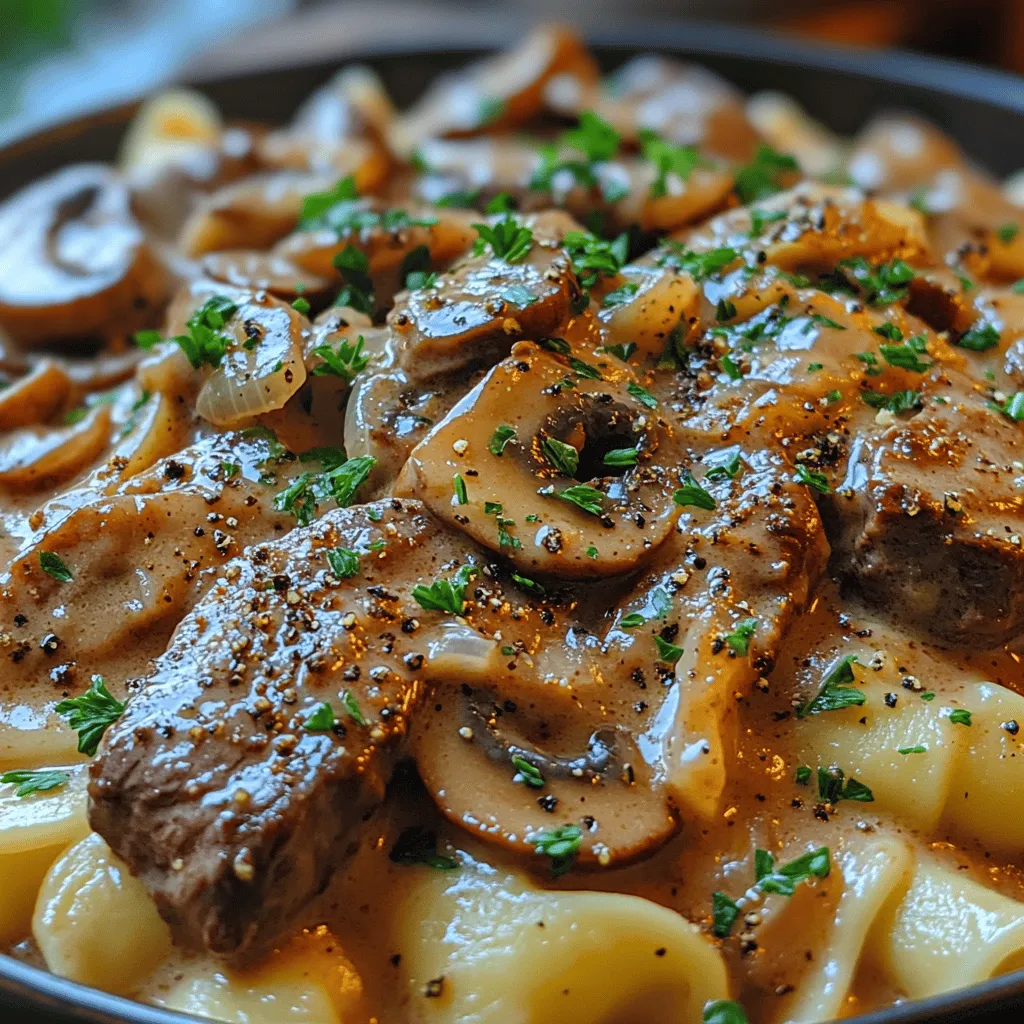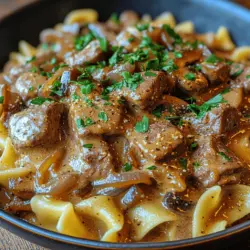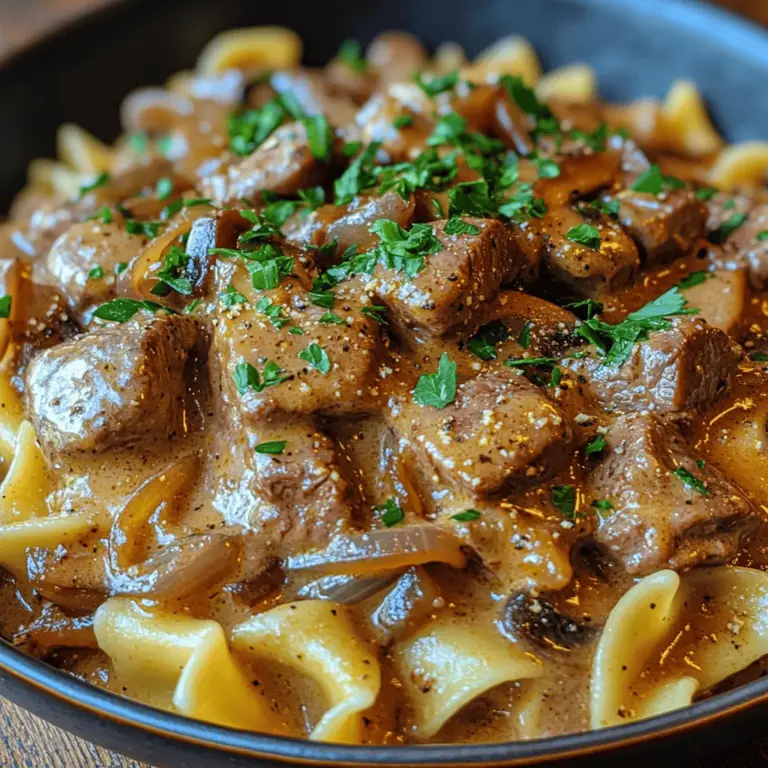Introduction
Beef stroganoff is a classic dish that has warmed hearts and satisfied appetites for generations. This creamy, savory delight combines tender beef strips with a rich, flavorful sauce, making it a staple comfort food in many households. Its appeal lies not only in its delectable taste but also in its ability to be prepared quickly, making it an ideal choice for busy weeknights or special occasions alike. Whether you choose to serve it over a bed of buttery egg noodles or fluffy white rice, beef stroganoff offers a satisfying meal that brings joy to the dinner table.
What makes beef stroganoff even more enticing is its versatility. You can adapt the recipe to suit your taste preferences or dietary needs. From adding a splash of red wine for depth to incorporating various mushrooms for an earthier flavor, there are countless ways to make this dish your own. With the perfect balance of creamy and savory elements, beef stroganoff is sure to become a favorite in your culinary repertoire.
The History of Beef Stroganoff
The origins of beef stroganoff can be traced back to 19th-century Russia. Named after the influential Stroganov family, the dish was initially a simple preparation of sautéed beef served with a mustard sauce. Over the years, it evolved into the creamy dish we know today, thanks to the influence of French cuisine, which emphasized rich sauces and gourmet presentations.
As the dish gained popularity, it began to spread beyond Russian borders. It became a beloved recipe in various countries, each adding its own twist. In the United States, for example, beef stroganoff became particularly popular during the mid-20th century, especially as families began to embrace convenience cooking. Canned soups and pre-packaged ingredients often found their way into American versions of the dish, simplifying the preparation process.
Globally, variations of beef stroganoff continue to emerge. In Sweden, for instance, the dish may include lingonberry sauce, while in Brazil, it is often served with potato sticks. Each adaptation pays homage to the rich history of beef stroganoff, showcasing its ability to transcend cultures while maintaining its core essence.
Key Ingredients of Heavenly Beef Stroganoff
To create a truly heavenly beef stroganoff, selecting the right ingredients is essential. Each component plays a vital role in developing the dish’s unique flavor profile and texture. Here’s a closer look at the key ingredients that make this recipe shine:
Beef Sirloin
At the heart of any beef stroganoff is the beef itself. Beef sirloin is often recommended for this dish due to its tenderness and rich flavor. This cut strikes a balance between being lean and flavorful, ensuring that each bite is succulent. When cooked quickly over high heat, beef sirloin retains its juiciness, making it perfect for a quick sauté. For the best results, slice the beef against the grain into thin strips, allowing for easy chewing and enhanced tenderness.
Olive Oil
Olive oil is a staple in many kitchens, and for good reason. Not only does it provide a healthful source of fat, but it also enhances the flavors of the other ingredients. Extra virgin olive oil is particularly beneficial, as it retains more of its natural antioxidants and healthy fats. In beef stroganoff, olive oil is used to sear the beef and sauté the aromatics, creating a foundational layer of flavor that sets the stage for the entire dish.
Onions and Garlic
Onions and garlic form the aromatic base of countless recipes, and beef stroganoff is no exception. Onions add sweetness and depth, while garlic contributes a punch of flavor that elevates the dish. Sautéing these ingredients until they are translucent releases their natural sugars, creating a savory backdrop that complements the beef and sauce. For optimal results, use yellow onions, as they provide a perfect balance of sweetness and sharpness.
Mushrooms
Mushrooms are a must-have ingredient in beef stroganoff, bringing a hearty umami flavor and a satisfying texture. Varieties such as cremini or button mushrooms work wonderfully, as they absorb the sauce and enhance the overall dish. Sautéing the mushrooms until they are golden brown caramelizes their sugars, intensifying their flavor and giving the sauce a rich, earthy profile.
Dijon Mustard
Dijon mustard is a key ingredient that adds an intriguing complexity to the sauce. Its tangy and slightly spicy notes brighten the dish, cutting through the richness of the cream and beef. The mustard not only enhances the flavor but also contributes to the sauce’s smooth consistency. A small amount goes a long way, allowing you to achieve that perfect balance of flavors without overwhelming the dish.
Beef Broth and Worcestershire Sauce
To build the sauce’s depth, beef broth is essential. It provides a rich, savory foundation that complements the beef and mushrooms. Using homemade or high-quality store-bought broth will yield the best results. Worcestershire sauce is another vital ingredient that adds a hint of sweetness and complexity. The combination of savory, sweet, and tangy flavors helps create a sauce that envelops the beef and mushrooms perfectly.
Flour
Flour serves a crucial role in thickening the sauce, giving it that creamy, luscious texture we all love in beef stroganoff. After sautéing the beef and vegetables, a small amount of flour is sprinkled over the mixture to create a roux. This step is essential for achieving the right consistency without making the sauce too heavy. For a gluten-free option, consider using cornstarch or a gluten-free flour blend.
Smoked Paprika
Smoked paprika is the secret ingredient that adds a subtle smokiness to the dish, enhancing its flavor profile. This spice not only contributes a beautiful color but also deepens the overall taste, making each bite more complex. A little goes a long way, so be careful not to overpower the other flavors. The smokiness works harmoniously with the beef and allows the dish to stand out.
Sour Cream
Sour cream is what gives beef stroganoff its signature creaminess and tang. Incorporating sour cream into the sauce not only enriches the texture but also balances the flavors beautifully. It’s important to add sour cream at the end of the cooking process to prevent curdling. For a lighter version, consider using Greek yogurt, which offers a similar tangy flavor with less fat.
Fresh Parsley
Finally, fresh parsley adds a pop of color and brightness to the dish. Its herbaceous flavor complements the richness of the sauce, providing a refreshing contrast. Chopping fresh parsley and sprinkling it over the finished dish not only enhances its visual appeal but also adds a final touch of flavor that ties all the elements together.
—
As we delve deeper into the preparation of this beloved dish, the next steps will guide you through the process of crafting your very own heavenly beef stroganoff. Stay tuned for the detailed cooking instructions and tips to ensure your dish turns out perfectly every time.

Serving Suggestions: Egg Noodles or Rice
Beef Stroganoff is classically served over egg noodles, which perfectly soak up the rich, creamy sauce. However, if you’re looking for a different base, rice is an excellent alternative. Here are some serving suggestions to elevate your dish:
– Egg Noodles: Choose wide egg noodles for a traditional approach; their flat surface captures the sauce beautifully. To prepare, cook them according to package instructions until al dente, then drain and toss them lightly with a bit of olive oil to prevent sticking.
– Rice: For a gluten-free option, serve your beef stroganoff over fluffy white or brown rice. Jasmine or basmati rice adds an aromatic touch, while quinoa can offer a protein boost.
– Mashed Potatoes: For a heartier meal, consider serving the stroganoff over creamy mashed potatoes, adding a comforting layer that pairs well with the savory sauce.
– Bread Bowl: For a fun twist, serve beef stroganoff in a hollowed-out bread bowl. This not only adds a rustic charm but also allows for a deliciously edible vessel that soaks up the sauce.
Step-by-Step Instructions for Preparing Beef Stroganoff
Preparation of Beef: Slicing Technique for Optimal Tenderness
To achieve tender beef in your stroganoff, start with the right cut. Sirloin or tenderloin is ideal for this recipe. Begin by placing the beef in the freezer for about 30 minutes; this will firm it up, making it easier to slice. Once slightly frozen, remove it and cut against the grain into thin strips, about ¼ inch thick. Slicing against the grain will break down muscle fibers, resulting in a more tender bite.
Sautéing Onions and Garlic: Tips for Achieving the Perfect Sauté
In a large skillet, heat 2 tablespoons of olive oil over medium heat. Add finely chopped onions and sauté for 4-5 minutes until they become translucent. The key to achieving the perfect sauté is to stir frequently and avoid overcrowding the pan, which can cause steaming instead of browning. Next, add minced garlic and sauté for an additional minute, just until fragrant. Be careful not to overcook the garlic, as it can turn bitter.
Cooking Mushrooms: How to Enhance Their Flavor
For the mushrooms, use cremini or button mushrooms for depth of flavor. Clean them with a damp cloth and slice them into thick pieces. Add the sliced mushrooms to the skillet with the onions and garlic, sautéing until they are golden brown and their moisture has evaporated, about 6-8 minutes. To enhance their flavor, season with a pinch of salt and pepper during cooking. This helps to draw out their natural umami taste.
Properly Cooking the Beef: Ensuring the Right Doneness
Once the mushrooms are cooked, push them to the side of the skillet and increase the heat to medium-high. Add the prepared beef strips in a single layer, ensuring they are not overcrowded. Cook them for about 2-3 minutes without moving them; this allows for a nice sear. Stir occasionally until the beef is browned but still slightly pink in the center. This method helps to lock in the juices, making the beef tender and flavorful.
Creating the Sauce: Combining Ingredients for the Perfect Consistency
After the beef is cooked, reduce the heat to medium and sprinkle in 2 tablespoons of flour, stirring continuously for about a minute. This step helps to thicken the sauce. Gradually pour in 1 cup of beef broth and 1 cup of sour cream, stirring until fully combined and the sauce is smooth. Be sure to scrape the bottom of the pan to incorporate any brown bits for added flavor. Allow the sauce to simmer for about 5 minutes, adjusting the seasoning with salt, pepper, and a dash of Worcestershire sauce for depth.
Cooking the Noodles or Rice: Timing for Optimal Texture
While the stroganoff sauce simmers, cook your chosen base. For egg noodles, bring a large pot of salted water to a boil and cook according to the package instructions until al dente. For rice, rinse 1 cup of rice under cold water, then combine it with 2 cups of water in a saucepan. Bring to a boil, cover, and reduce the heat to low, cooking for about 18-20 minutes until fluffy. Timing is crucial: aim to have your noodles or rice ready just as the sauce finishes simmering.
Assembling the Dish: Plating Tips for a Beautiful Presentation
To serve, place a generous helping of your chosen base—egg noodles or rice—on each plate. Ladle the beef stroganoff sauce over the top, ensuring each plate is well-coated. For a final touch, garnish with freshly chopped parsley or chives, adding a pop of color and freshness. Serve immediately while hot, allowing everyone to enjoy the comforting aroma of this hearty dish.
Nutritional Information of Beef Stroganoff
A typical serving of beef stroganoff (approximately 1 cup) contains the following nutritional breakdown:
– Calories: 400-500
– Protein: 25-30 grams
– Fats: 20-25 grams
– Carbohydrates: 30-40 grams
Discussion of Nutritional Benefits of the Ingredients Used
The primary ingredients in beef stroganoff provide various nutritional benefits. Beef is an excellent source of high-quality protein, essential for muscle growth and repair. It also contains important vitamins and minerals, such as iron and zinc. The addition of mushrooms contributes antioxidants and B vitamins, while onions and garlic offer anti-inflammatory properties.
Considerations for Dietary Preferences
For those with dietary restrictions, beef stroganoff can be adapted. To make it gluten-free, simply use gluten-free flour or cornstarch for thickening and serve over rice or gluten-free noodles. For a lighter version, consider using chicken or turkey instead of beef, or substitute the sour cream with Greek yogurt for a healthier twist.
Serving Suggestions and Pairings
To elevate your beef stroganoff experience, consider these serving suggestions:
– Ideal Side Dishes: Serve with a crisp green salad tossed in a light vinaigrette, roasted vegetables, or steamed broccoli to provide a refreshing contrast to the rich stroganoff. Garlic bread is also a fantastic choice to soak up the delicious sauce.
– Wine Pairings: A medium-bodied red wine, such as Merlot or Pinot Noir, complements the beef’s richness beautifully. If you prefer white wine, a buttery Chardonnay can also work nicely.
– Creative Twists on Serving Beef Stroganoff: For a unique presentation, try serving beef stroganoff in a baked puff pastry shell or even atop crispy polenta rounds. These alternatives not only add an element of surprise but also enhance the overall dining experience.
Conclusion
Beef stroganoff is a classic comfort food that brings warmth and satisfaction to any table. With its tender beef, creamy sauce, and satisfying base, it is a dish that resonates with home-cooked love. By following this recipe, you can recreate the deliciousness of this timeless dish in your own kitchen.
We encourage you to try making beef stroganoff at home and share it with your loved ones. Cooking is about more than just nourishment; it’s about creating memories and enjoying the simple pleasure of a homemade meal together. So gather your ingredients, roll up your sleeves, and embark on this culinary adventure. Your family and friends will thank you for it!


